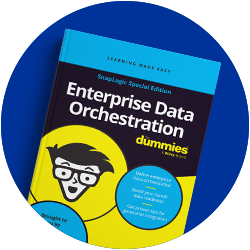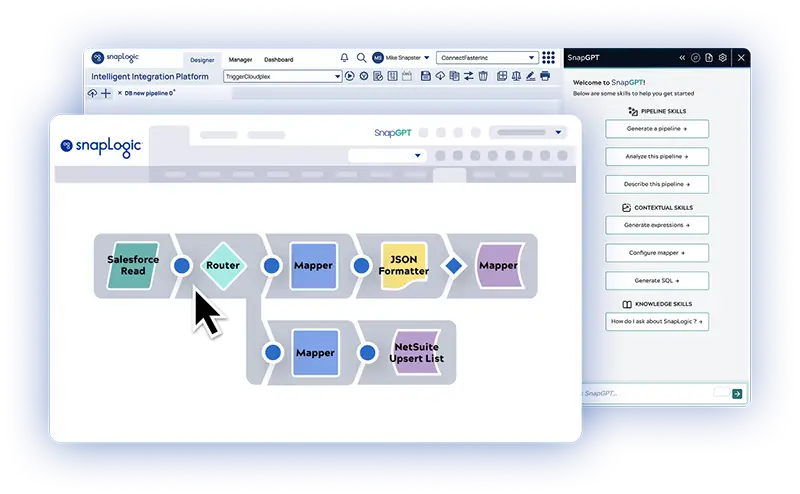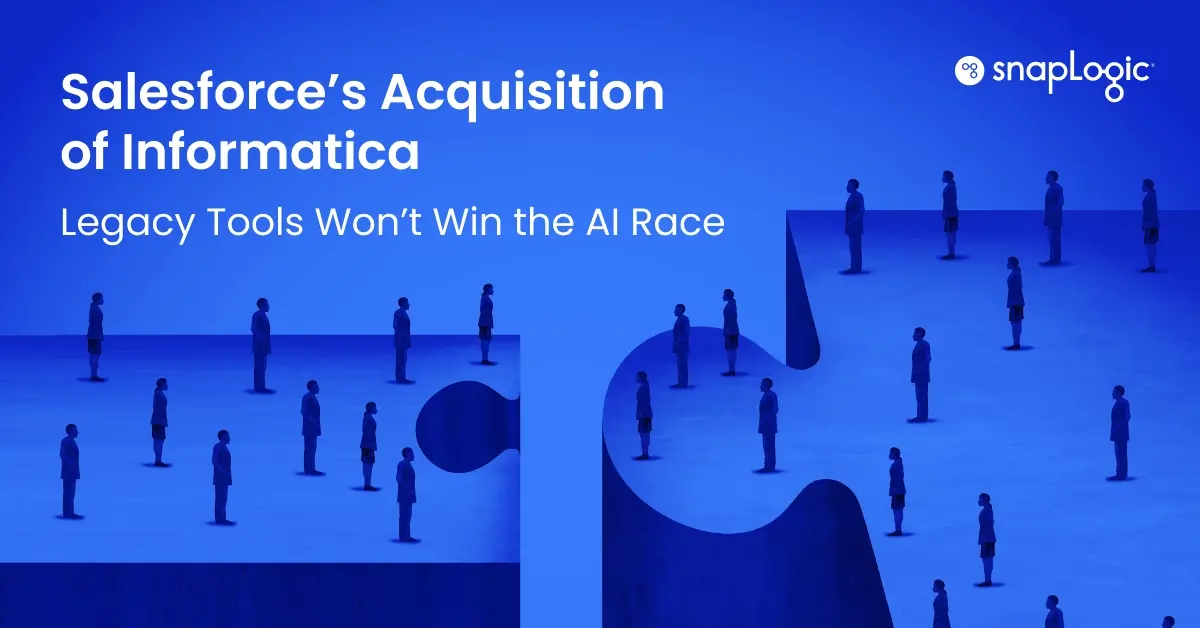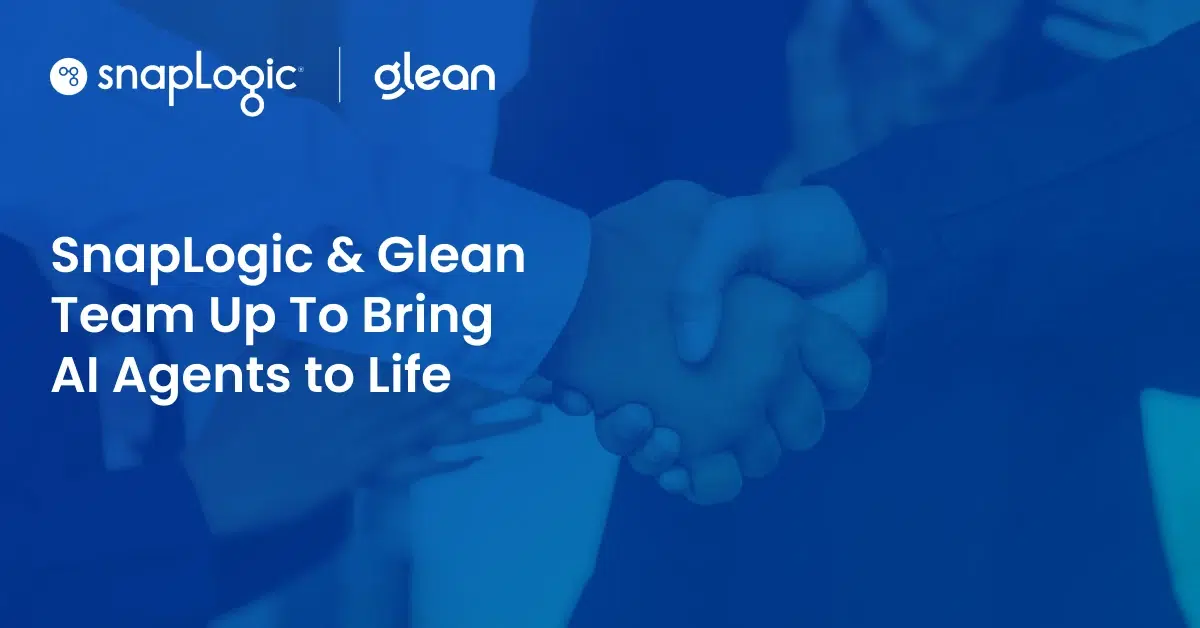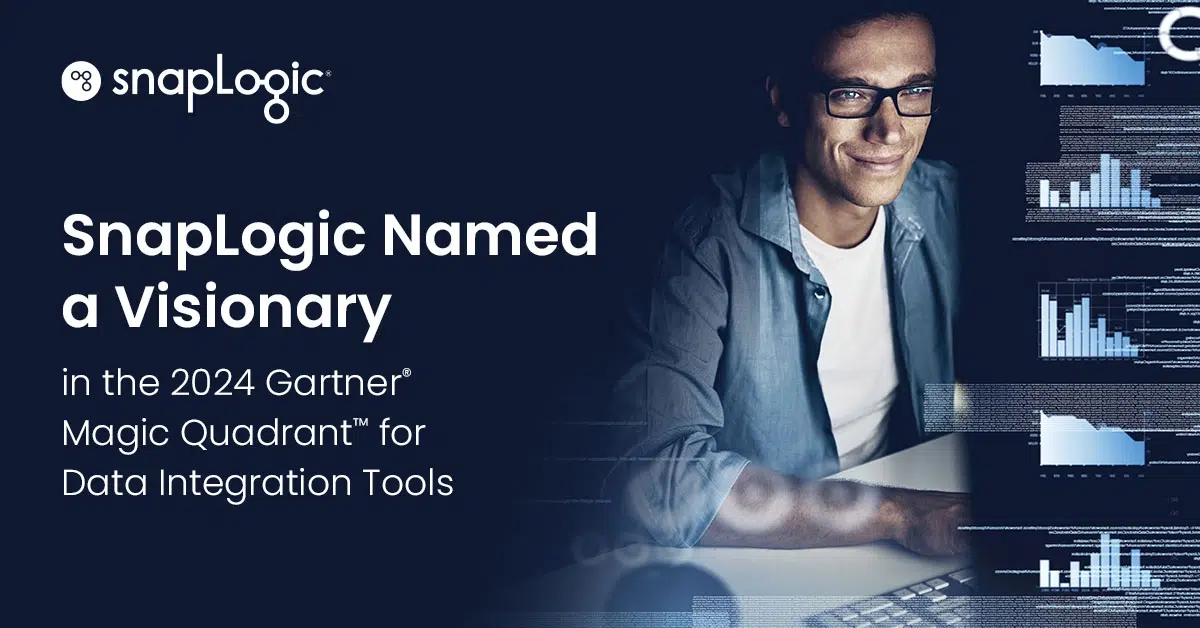In der Welt der Integration hat sich in den letzten Monaten einiges getan. Vor ein paar Wochen wurde der Gartner iPaaS MQ mit einigen überraschenden Entwicklungen und Berichten veröffentlicht, und kurz darauf wurde die Integrationswelt durch die große Nachricht aufgewühlt: Die Vereinbarung von Salesforce, Informatica für 8 Milliarden Dollar zu kaufen. Es ist sicherlich eine aufregende Zeit, in diesem wachsenden Markt zu sein.
Auf der einen Seite ist die Übernahme eine Bestätigung. Dieser Schritt ist ein klares Signal, dass der Markt anerkennt, was wir schon seit Jahren glauben: Unternehmen brauchen eine Plattform, die Daten- und Anwendungsintegration mit starken Orchestrierungsfunktionen vereint, und jetzt brauchen Sie eindeutig die Möglichkeit, KI-gestützte Agenten zu starten. Aber all diese Funktionen im Portfolio eines Anbieters zu haben, bedeutet noch lange nicht, dass sie auf einheitliche Weise bereitgestellt werden.
Dies ist der Moment für Unternehmen, sich zu fragen: Geht es wirklich darum, mehr Einzelteile unter einem Anbieter zu haben, oder geht es darum, eine einheitliche Plattform zu haben, die tatsächlich als Einheit funktioniert?
Eine Welt der Fraktionen
Ich denke über diese Situation folgendermaßen. Wenn Sie den Film Divergent gesehen haben, erinnern Sie sich vielleicht an die Grundidee: Die Gesellschaft ist in starre Fraktionen aufgeteilt, die jeweils eine Tugend repräsentieren: Mut, Intelligenz, Ehrlichkeit, Freundlichkeit und Selbstlosigkeit. Jede Fraktion ist auf ihre eigene Weise stark, aber begrenzt, wenn sie isoliert ist.
Der heutige Integrationsmarkt ähnelt dieser fraktionsbasierten Welt:
- Es gibt Anbieter, die sich durch eine hervorragende Datenintegration auszeichnen, sich aber mit der Konnektivität moderner Anwendungen schwer tun.
- Sie verfügen über starke iPaaS-Akteure, die für SaaS-Workflows entwickelt wurden, denen es aber an Tiefe bei Datenpipelines oder Governance fehlt.
- Sie verfügen über API-Verwaltungstools, die für den Datenverkehr und die Sicherheit ausgelegt sind, aber nicht mit einer umfassenderen Automatisierung verbunden sind.
- Und jetzt gibt es eine wachsende Zahl von Agentenplattformen, die sich auf die KI-Orchestrierung konzentrieren, aber oft auf bestehende Systeme aufgesetzt werden.
Wenn diese spezialisierten Tools erworben und gebündelt werden, entsteht die Fassade der Einheitlichkeit. Aber darunter bleiben sie getrennte Codebasen, getrennte Betriebsmodelle und getrennte Benutzererfahrungen.
Anstatt Unternehmen dazu zu zwingen, diese Teile selbst zusammenzufügen, bringt SnapLogic sie alle durch Design zusammen. Die SnapLogic-Plattform vereint Datenintegration, App-Integration, APIM und die Erstellung von KI-Agenten in einer Komplettlösung, die es Unternehmen ermöglicht, die Komplexität zu vereinfachen und im Zeitalter der KI schneller voranzukommen.

Konsolidierung ≠ Vereinheitlichung
Der Deal zwischen Salesforce und Informatica ist ein perfektes Beispiel dafür. Durch die Übernahme von Informatica erweitert Salesforce sein Portfolio. Der Gründer und CEO von SnapLogic, Gaurav Dhillon (Gründer und ehemaliger CEO von Informatica), brachte es in einem kürzlich erschienenen Artikel der SF Business Times auf den Punkt: Die Übernahme ist eine gute Nachricht für die Aktionäre, aber eine Tragödie für die Kunden. Die Realität für die Kunden sind drei Codebases, mehr Integrationsaufwand und steigende Kosten für die Wartung und Verbindung dieser unterschiedlichen Teile.
Dies ist nicht die Konvergenz, die Kunden brauchen, um schneller voranzukommen oder KI-fähig zu werden. Es handelt sich um eine Konsolidierung des Eigentums der Anbieter, nicht um eine Vereinheitlichung der Architektur.
Führungskräfte sagen uns immer wieder, dass es ihnen nicht darum geht, mehr Tools zu sammeln. Sie wollen vereinfachen, vereinheitlichen und die Ergebnisse beschleunigen. Sie wollen Teams über die IT hinaus befähigen, Automatisierung ohne Reibungsverluste nutzen und KI ermöglichen, ohne neue Silos zu schaffen.
Die Linse des Analysten: Kategorien und Fähigkeiten
Der Integrationsmarkt heizt sich immer mehr auf - unterbrochen von aufsehenerregenden Akquisitionen und wechselnden Quadranten - und Analystenberichte bieten hilfreiche Signale, sagen aber immer nur einen Teil der Geschichte aus.
Im kürzlich veröffentlichten Gartner Magic Quadrant 2025 für Integration Platform as a Service (iPaaS) wurde SnapLogic als Visionär eingestuft und spiegelt damit wider, worauf zukunftsorientierte Unternehmen heute Wert legen:
- Benutzerfreundlichkeit und Schnelligkeit, die sowohl IT- als auch Geschäftsanwendern zugute kommen
- KI-gesteuerte Funktionen, die die Produktivität steigern und die Automatisierung beschleunigen
- Umfassende, flexible Konnektivität zwischen Cloud-, On-Premise- und Hybridsystemen
SnapLogic wurde auch als Visionär im jüngsten Magic Quadrant für Datenintegrationstools anerkannt, was unsere Überzeugung unterstreicht, dass die Unternehmensintegration sowohl die Anwendungs- als auch die Datenebene umfassen muss und nicht nur die eine oder die andere.
Über diese beiden Kategorien hinaus sehen wir auch eine zunehmende Anerkennung in angrenzenden, neu entstehenden Kategorien wie LLM-basierte KI-Agenten und No-Code-Agent-Builder sowie API-Lebenszyklusmanagement.
Diese Quadranten und Berichte sind zwar nützlich, aber sie bewerten Plattformen in der Regel isoliert und verstärken künstliche Grenzen zwischen den mittlerweile miteinander verbundenen Unternehmensfunktionen. So kann ein Bericht beispielsweise eine starke iPaaS-Lösung hervorheben, aber übersehen, ob sie sich gut mit Datentools integrieren lässt, moderne APIs unterstützt oder KI-gestützte Workflows ermöglicht.
Das ist der Punkt, an dem viele Plattformen versagen. Und hier weichen wir ab. In einem Markt, der von Konsolidierung getrieben wird, aber durch Fragmentierung eingeschränkt ist, stellt SnapLogic einen anderen Weg dar: keine zusammengenähte Sammlung von Tools, sondern eine einheitliche Plattform, die für das KI-Zeitalter entwickelt wurde.
Der abweichende Vorteil
In Divergent lässt sich die Protagonistin Tris nicht auf eine Fraktion festlegen - sie verkörpert die Stärken aller Fraktionen. Das ist genau das, was Unternehmen heute brauchen: eine einzige Plattform, die Datenintegration, Anwendungs- und API-Integration sowie die Erstellung von KI-Agenten in einem einzigen System vereint.
Wenn Sie diese Fähigkeiten von Haus aus und nicht durch Akquisition vereinheitlichen, können Sie sie freischalten:
- Echte architektonische Einfachheit, nicht nur Markenkonsolidierung
- Schnellere Wertschöpfung, da keine internen Nähte erforderlich sind, damit die einzelnen Teile zusammenarbeiten
- Breitere Akzeptanz, die sowohl technische als auch geschäftliche Teams zu grenzenloser Innovation befähigt
- Eine zukunftssichere Grundlage, die vom ersten Tag an für KI und ereignisgesteuerte Architekturen ausgelegt ist
Und die Ergebnisse sprechen für sich: Laut einer kürzlich durchgeführten Forrester Total Economic Impact™-Studie erzielten SnapLogic-Kunden einen ROI von 181 % mit einer Amortisierung in weniger als 6 Monaten, was die Leistungsfähigkeit einer wirklich einheitlichen Integrationsplattform bestätigt.
Unternehmen führen mit einheitlicher Integration
Während andere mit zusammengeflickten Stapeln weitermachen, gehen diese Unternehmen ihren eigenen Weg und setzen auf eine einheitliche Integration, um schneller voranzukommen, intelligenter zu arbeiten und sich auf das vorzubereiten, was als nächstes kommt.
Automatisierung der Kreditvergabe mit KI-Agenten
Die Independent Bank brauchte einen schnelleren Weg, um ihre Kunden zu bedienen und ihre Abläufe zu optimieren. Mit SnapLogic vereinheitlichte sie ihre Systeme und führte KI-Agenten ein, die wichtige Arbeitsabläufe bei der Kreditvergabe automatisieren, weniger komplex sind und schneller zum Einsatz kommen.
Vereinheitlichung von 1.500 Agenturen auf einer Integrationsplattform
Als eines der größten Marketing- und Kommunikationsnetzwerke der Welt ertrank Omnicom in unzusammenhängenden Tools. Durch die Standardisierung auf SnapLogic konnte das Unternehmen Daten, Prozesse und Teams in 1.500 Agenturen zusammenführen und so die Bereitstellung in großem Umfang beschleunigen.
GenAI mit moderner Integration vorantreiben
Um GenAI in die Produktion zu bringen, musste Spirent zunächst die alte Technologie hinter sich lassen. Mit SnapLogic modernisierte das Unternehmen seine Integrationsinfrastruktur, vereinfachte die Entwicklung und führte KI-gestützte Agenten für Vertrieb, Betrieb und IT ein. Und das alles mit einer zukunftssicheren Grundlage.
Diese Unternehmen haben nicht einfach nur modernisiert; sie haben sich entschieden, von veralteten Ansätzen abzuweichen, und gezeigt, dass eine einheitliche Integrationsplattform nicht nur möglich, sondern auch transformativ ist.
Divergenz als Strategie
In dem Film wird die Abweichung als Bedrohung für das starre System gesehen. Doch letztlich sind es die Abweichler, die führen und überleben. In ähnlicher Weise sind es die Unternehmen, die es wagen, vom Status quo abzuweichen, die Agilität, Kompositionsfähigkeit und Widerstandsfähigkeit für die Zukunft aufbauen.
Anstatt erworbene Tools übereinander zu stapeln, haben sie sich für eine Vereinheitlichung vom Kern her entschieden:
- Datenintegration und Anwendungsintegration basieren auf der gleichen Grundlage
- APIs werden als Teil desselben Gefüges geregelt und verwaltet
- KI-Agenten werden als natürliche Erweiterung der gleichen Plattform erstellt und orchestriert
Dies ist keine Zukunft, die durch Übernahmen zusammengeflickt wird. Es ist eine Plattform, die von Anfang an als Einheit funktionieren soll.
Alles unter einen Hut bringen
Der Integrationsmarkt konsolidiert sich schnell, aber Konsolidierung allein führt nicht zu Einfachheit. Nur eine Abweichung vom Status quo - die Wahl eines einheitlichen, nativ integrierten Ansatzes - kann Unternehmen auf die nächste Ära des KI-gestützten, kompositionsfähigen Geschäfts vorbereiten.
Wie Tris in Divergent werden die erfolgreichsten Unternehmen diejenigen sein, die sich weigern, sich einer Fraktion anzuschließen oder fragmentierte Lösungen als einzige Option zu akzeptieren. Stattdessen nutzen sie die Stärken aller Bereiche, vereint auf einer einzigen intelligenten Plattform.
Sind Sie bereit, vom Status quo abzuweichen?
Sprechen Sie mit uns, um herauszufinden, wie eine einheitliche, agentenbasierte Integrationsplattform Ihr Unternehmen vereinfachen, skalieren und in einer KI-gesteuerten Zukunft ohne Kompromisse erfolgreich sein kann.
Und wenn Sie nach einer ganzheitlicheren Perspektive suchen, ist eine neue im Entstehen. Das tPaaS-Framework (Transformation Platform as a Service) von Aragon Research ist ein solches Beispiel. Das von ehemaligen Gartner-Analysten geleitete tPaaS-Framework bewertet Anbieter nach ihrer Fähigkeit, Integration, Automatisierung und KI im gesamten Unternehmen zu vereinen. Es ist ein Zeichen dafür, dass der Markt beginnt, traditionelle Schwimmwege zu hinterfragen. Und dass man erkennt, dass die Transformation vernetzte Fähigkeiten erfordert, nicht unverbundene Kategorien.

